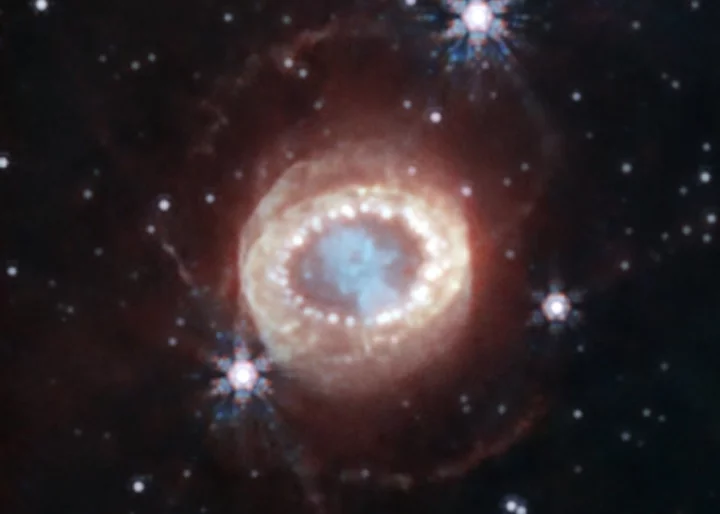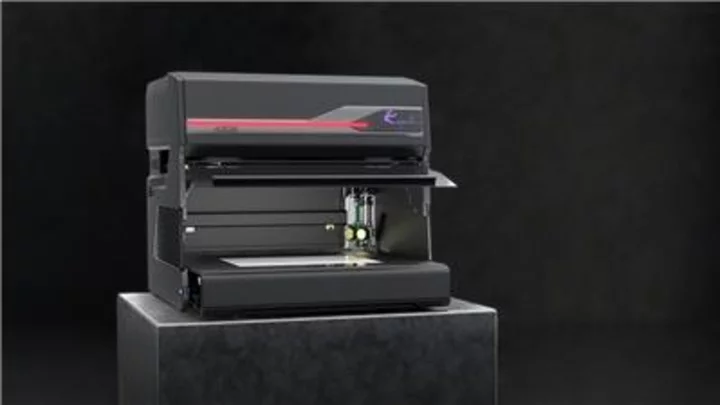This celestial masterpiece has been compared to the electric colors of a jellyfish, the gaping mouth of an eel, and even J. R. R. Tolkien's Eye of Sauron.
NASA's Hubble, Spitzer, and Chandra X-ray telescopes have all viewed this famous supernova — aka SN 1987A — before, but it wasn't until astronomers pointed the James Webb Space Telescope at it that they could see it in high definition. But it's not just a pretty picture: The leading infrared telescope, a collaboration of NASA and the European and Canadian space agencies, has revealed new mysterious details in the remains of the exploded star.
Because infrared light is invisible to human eyes, researchers have translated the data into visible-light wavelengths, sort of like playing a tune in a lower octave. What they found was a pair of small, peculiar crescent-shaped features, surrounding something that looks like a keyhole opening at the center of a gas cloud.
But what exactly are they? Even the experts are wondering whether Webb's "eye" is playing tricks on them.
"Their brightness may be an indication of limb brightening, an optical phenomenon that results from viewing the expanding material in three dimensions," according to NASA. "In other words, our viewing angle makes it appear that there is more material in these two crescents than there actually may be."
SEE ALSO: Webb telescope captures the divine colors of a star's deathSolving this mystery may help scientists better understand how stellar corpses evolve over time.
Stars on the verge of dying and supernovas like SN 1987A are element factories, astrophysicists say: They make carbon, for instance, the same chemical on which humans and much of life on Earth are based. Then they spread metals like calcium found in bones and iron in blood across interstellar space. This dispersal seeds new generations of stars and planets, but scientists admit they have much to learn about the early stages of the process.
In the new Webb image, the keyhole at the center is packed with clumps of gas and dust from the explosion.
The supernova SN 1987A as viewed by the James Webb Space Telescope. Credit: NASA / ESA / CSA / Mikako Matsuura / Richard Arendt / Claes Fransson / Josefin Larsson (KTH)Want more science and tech news delivered straight to your inbox? Sign up for Mashable's Light Speed newsletter today.
"The dust is so dense that even near-infrared light that Webb detects can’t penetrate it, shaping the dark 'hole' in the keyhole," according to NASA.
A bright belt around the middle connects two faint limbs of hourglass-shaped outer rings. The belt is composed of material fired from the star tens of thousands of years before it died. It's studded with hot spots that appeared as the supernova’s shock wave hit the belt. Now spots are showing up outside the band, with diffuse emissions surrounding it. Scientists say this finding is an important benchmark in the supernova's progression.
The Hubble Space Telescope shows Supernova 1987A in the Large Magellanic Cloud. Credit: NASA / ESA / R. Kirshner / M. Mutchler / R. AvilaAstronomers discovered SN 1987A, an intriguing and relatively close cosmic object, nearly 40 years ago in the Large Magellanic Cloud, a small satellite galaxy of the Milky Way. Since then, scientists have investigated it at radio, gamma-ray, and X-ray wavelengths. They continue to monitor the aftermath because so much of it remains an enigma.
For example, scientists believe there should be a black hole or neutron star left over from the blast. Yet no telescope has found one among the ashes.
With time and the help of other telescope observatories, perhaps it's another mystery Webb will unravel.









